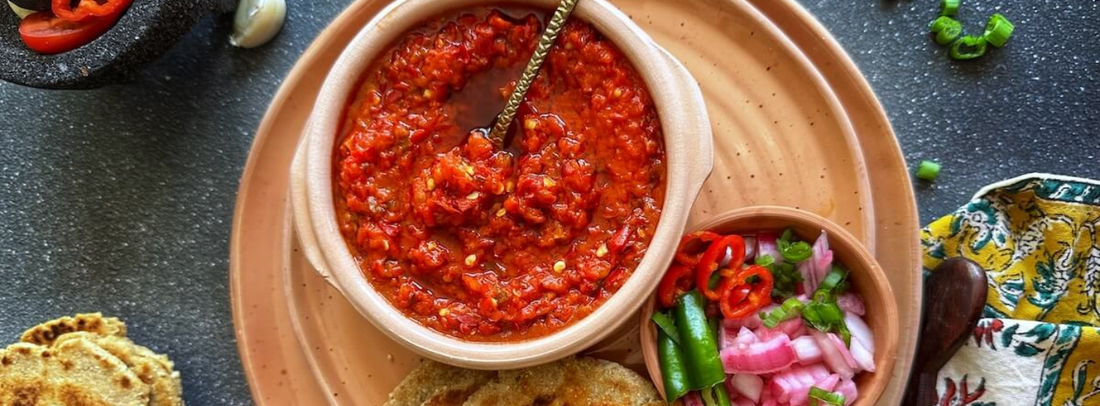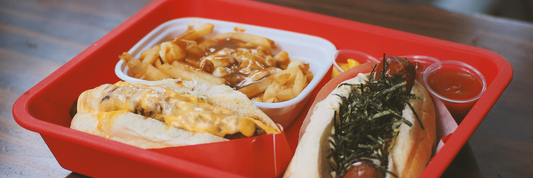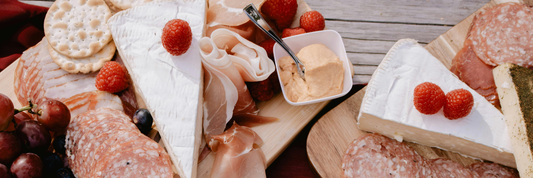Garlic chutney bold, spicy, and deeply aromatic is one of India’s most iconic condiments. Made from roasted garlic, red chilies, and a touch of tangy tamarind, this vibrant relish adds instant flavor to everything from dosa and vada pav to wraps, noodles, and grilled meats.
For chefs and restaurant owners, garlic chutney isn’t just a side dish, it’s a versatile flavor base that elevates menus, attracts adventurous diners, and pairs beautifully with both traditional and fusion cuisine. Whether served as a dip, spread, or marinade, it delivers the punch of spice and depth that modern palates crave.
In this guide, Kimecopak.ca explores the origins, variations, and creative uses of garlic chutney plus expert tips on preparing, storing, and serving it sustainably in your kitchen.
- Chutney: What Is It, Common Chutney Recipes & What Is Chutney Served With?
- Beetroot Chutney: A Flavorful Guide for Chefs
- What Is The Difference Between Chutney And Pickle?
What is Garlic Chutney?

Garlic chutney (often called lahsun chutney in Hindi) is a fiery condiment made primarily from garlic, chili peppers, vinegar or tamarind, and oil. Its base ingredients can be adjusted to create everything from a smooth dipping sauce to a coarse dry seasoning.
The taste is unmistakable, a combination of pungent garlic, spicy heat, and a hint of tanginess that awakens the palate. It pairs beautifully with Indian breads, snacks, and curries, but it’s just as at home in a wrap, burger, or noodle bowl.
A Cultural Journey Through India’s Kitchens
Garlic chutney’s story begins in India, where it has been crafted for generations using regional techniques and local produce. Each state adds its own twist, creating a tapestry of flavors that reflects India’s culinary diversity.
Maharashtrian Garlic Chutney
This dry, coarse version uses roasted garlic, dried chilies, and ground peanuts. The texture resembles a powder, perfect for sprinkling over bhakri or rice mixed with ghee. It delivers intense heat balanced by nutty undertones.
South Indian Garlic Chutney
Here, garlic meets coconut, tamarind, and curry leaves resulting in a tangy, aromatic condiment often served with idli, dosa, or uttapam. The use of fresh ingredients gives it a lush, tropical flavor.
North Indian Garlic Chutney
This version features mustard seeds, coriander, and cumin, creating a warm, earthy profile. It’s typically blended smooth and used as a base for curries or spreads for flatbreads.
Across India, you’ll also find versions incorporating jaggery, ginger, or lemon juice, reflecting the country’s culinary creativity.
As Indian food gained global popularity, garlic chutney inspired fusion versions think Thai-style chili-garlic pastes or Mexican salsas with Indian spice blends.

How to Make Garlic Chutney
Ingredients for Making Garlic Chutney
- 1 cup peeled garlic cloves
- 6–8 dried red chilies (adjust to taste)
- 1 tbsp tamarind pulp or 1 tsp vinegar
- 1 tsp cumin seeds
- 2 tbsp peanut or sesame oil
- Salt to taste
- Optional: a pinch of jaggery for balance
Equipment for Making Garlic Chutney
- Skillet for roasting
- Blender or mortar and pestle
- Airtight jar for storage
Step-by-Step Preparation
- Roast the garlic and chilies
Heat oil in a skillet. Add garlic and chilies; roast until lightly browned and fragrant. This step deepens flavor and reduces harshness. - Blend with spices
Combine roasted garlic, chilies, cumin, and salt in a blender. Add tamarind and a splash of water to create a smooth paste. - Taste and adjust
Add more tamarind for tang, salt for depth, or a touch of jaggery for balance. - Cool and store
Transfer to a clean jar and let it cool before sealing. Refrigerate for up to 10 days or freeze in small portions.
For a dry variation, skip water and grind ingredients into a crumbly mix.
Sustainability Insight: Serving and Storing Garlic Chutney Responsibly
Sustainability in food service isn’t just about ingredients, it’s about how we package and serve them. Garlic chutney, often used in small quantities, can generate a lot of plastic waste if served in disposable cups.
At Kimecopak.ca, we encourage restaurants to store and serve sauces in eco-friendly containers:
- Compostable sauce cups for takeout orders
-
Paper containers for in-house serving
These small choices reduce environmental impact and enhance your brand’s sustainability story.
Key Characteristics of Garlic Chutney

Flavor
Garlic chutney is known for its bold taste, blending the pungency of garlic with the heat of chili peppers and a touch of acidity from vinegar or tamarind. Depending on the recipe, it can range from mildly tangy to intensely spicy.
Texture
The consistency of garlic chutney varies from smooth pastes to coarsely ground mixes. Traditional methods involve hand-grinding, while modern recipes use blenders or food processors for convenience.
Heat Level
The spice intensity depends on the type and quantity of chili peppers used. Some versions are milder with a balanced garlic flavor, while others pack a fiery punch.
Traditional and Modern Variations
Traditional Variations
- Dry Garlic Chutney: Made with roasted garlic, dried chilies, and coconut, perfect as a seasoning.
- Wet Garlic Chutney: A fresh blend of garlic, vinegar, and chilies, ideal for dips and spreads.
Modern Variations
- Fusion Chutneys: Incorporating ingredients like sun-dried tomatoes, roasted bell peppers, or even smoked paprika for a unique twist.
- Vegan-Friendly Chutney: Using olive oil and plant-based ingredients to suit a vegan diet.
- Mild Garlic Chutney: Reduced chili content for those who prefer a less spicy option.
Related read: Beetroot Chutney: A Flavorful Guide for Chefs, another colorful, earthy condiment to add variety to your restaurant menu.
Culinary Applications of Garlic Chutney
Garlic chutney is incredibly versatile, enhancing dishes in various ways:
As a Condiment
- Curries: Adds depth and heat to traditional Indian curries.
- Grilled Meats & Seafood: Perfect as a side for chicken, fish, or steak.
- Sandwiches & Wraps: A flavorful spread that pairs well with cheese, veggies, or grilled proteins.
As a Marinade
- Chicken: Infuses bold flavors into grilled or roasted chicken.
- Fish: Enhances the taste of seafood with its tangy and spicy elements.
- Tofu: Ideal for plant-based dishes, adding a smoky and garlicky kick.
As a Base for Sauces & Dips
- Spicy Yogurt Dip: Mixed with yogurt for a cooling yet flavorful dip.
- Aioli Alternative: Blended with mayonnaise for a garlicky sandwich spread.
- Stir-Fry Sauce: Used as a base for Asian-inspired dishes.

Frequently Asked Questions About Garlic Chutney
What is garlic chutney made of?
It is typically made with garlic, chilies, oil, and acidic elements like vinegar or tamarind. Additional spices such as cumin or mustard seeds enhance flavor.
Is garlic chutney vegan?
Yes, most versions are naturally vegan. Just choose plant-based oils instead of ghee if needed.
How long can I store garlic chutney?
Wet versions last about a week in the fridge, while dry powdered types can stay fresh for up to three weeks in airtight containers.
How can I reduce the spice level?
Use fewer chilies or replace half with roasted bell peppers for a milder flavor.
What dishes pair best with garlic chutney?
It’s great with dosas, sandwiches, rice bowls, and grilled meats. Try experimenting with fusion cuisines like tacos or pasta sauces.
Conclusion
Garlic chutney is so much more than a spicy side, it’s a culinary statement. Its robust, versatile flavor turns simple ingredients into memorable dishes. From traditional Indian meals to modern fusion creations, its adaptability makes it a must-have for restaurants looking to stand out.
By preparing it in batches, experimenting with regional variations, and serving it in eco-friendly packaging, chefs can deliver both taste and sustainability to their customers.
Visit Kimecopak.ca for more eco-friendly packaging solutions and culinary guides and explore how simple sauces like garlic chutney can make a big impact on flavor and the planet.







